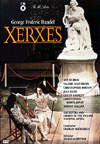Xerxes
Image Entertainment
Cast: Ann Murray, Valerie Masterson, Christopher Robson, Jean Rigby
Extras:
Rating:
Handel was a German immigrant to England who never became fluent in the language of his adoptive country. Thankfully, this didn’t keep him from composing some of the greatest music ever written – most of it to lyrics in either Italian or English, both foreign to him. This circumstance appears to have been marvelously focusing. No composer of note was more prolific and so often met with success.
You might not be as convinced of Beethoven’s mighty endorsement based on "Xerxes" as you might other of Handel’s more consistently inspired operas. "Xerxes" came latterly in Handel’s long career. Based on an earlier Venetian opera of the same name, performed in 1645 and composed by Cavalli, it was first performed at the King’s Theatre, Haymarket, London, in 1738. Like subtle wine that doesn’t much impress in the imbibing, "Xerxes" really delivers in the aftertaste.
You could succumb to terminal boredom attempting to sort out the various goings-on. Fortunately, Hytner’s ingeniously surrealist handling of the action appears shrewdly designed to throw you off the scent. Hytner’s solution to the irrelevancy of all but the amorous aspects of the plot is to reduce its impenetrability still further to virtual incoherency. A bridge between two nations, for example, is a model in a glass case! Hytner translates the setting of Ancient Persia to someplace veddy veddy English, via a time warp that places it in 1736 while at the same time making it vaguely futuristic.
Color use contributes tremendously to what little drama there is. David Fielding’s bright, handsome design is essentially the Vauxhall Gardens in the London of Handel’s time. Its outdoors indoors rather anticipates the spirit of the poet Byron and his crowd amidst green fields and marble ruins.
Longtime principal ENO conductor Charles Mackerras has prepared his own edition of "Xerxes" which serves ideally, as does his baton in the pit. Nothing improves the undistinguished overture, which the video uses expeditiously for the credits. There’s even time for a nicely visual montage identifying each character in turn. This at least gives us a fighting chance to sort out who’s who. An apology that "imbecilities…are the basis of the story" shrewdly underlines the folly of our even attempting to tackle the plot.
When a composer churns out as much as Handel does, you might expect he’d not infrequently be on autopilot. Handel’s muse is never less than engaged throughout, but it too often seems to lack the spark of divinity. Ever the consummate showman, however, he picks up the pace just in time for the end of the mammoth first act. We’re rewarded with three successive arias of genuine intensity and urgency within the context of the artificial action.
The English National Opera is a repertory company. Its performers are accustomed to working together, resulting in exceptionally involved and involving dramatic relationships. This is opera acting at its most expressive and subtle.
Like Xerxes, Amastris is a so-called ’travesty’ or ’trouser role’ familiar to us from Mozart where males youths were often portrayed by female singers with lower voices. We accept this on practical grounds; young males voices might prove too fragile for the vocal dexterity demanded, not to mention the depth of expression. In a twist, Amastris turns out to be a woman – a double transvestite!
The countertenor experience may be unsettling to the uninitiated. Christopher Robson as Arsamenes is a man playing a man but with a woman’s voice. The sound is odd to modern ears, but Robson’s skill in negotiating an evening’s worth of precise and impassioned articulation has to be lauded.
Anyway, to recap: the leader of one nation (Xerxes) and the heir(ess) apparent to another (Amastris) are both women as men, and the brother of the former (Arsamenes) is a man with the voice of a woman. Well, that’s royal inbreeding for you!
To confuse matters further, in Handel’s time the title role was sung by a male whose testicles were surgically removed to give him a naturally (if that’s quite the right term) higher voice. We are not accustomed to giving quite all to art these days, so we have little evidence to judge how much of a difference this would make. To the voice, I mean.
Analog video edge artifacting is present throughout. Thankfully, the production’s brightness tends to minimize it. Relatively static screen activity yields amazing image detail for the PAL system of 1988. On the other hand, character or camera motion inordinately blurs the image. It’s hard to pin down exactly why, but it would appear to be a compression issue compounded by transcription between systems of incompatible frame rates. The picture is largely noise free, a tremendous help.
Expect zero for extras. Frankly, this title could have used optional English subtitles – not to reiterate what’s sung, but to remind us who’s who and what’s happening. After all, this is what half the audience is consulting the other half to learn!







